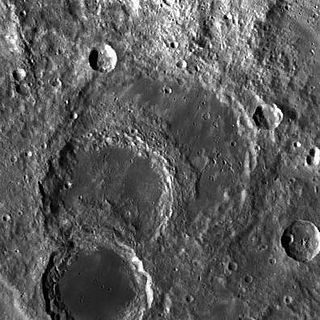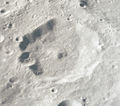
Beals is a lunar impact crater that is located near the eastern limb of the Moon, and lies across the southwestern rim of the crater Riemann. From the Earth the crater is viewed nearly from on edge, and is best seen during favorable librations. To the west is the large walled plain Gauss.

Dawson is a lunar impact crater that lies on the southern hemisphere on the far side of the Moon. It lies across a crater triplet: the southeast rim is intruding into the crater Alekhin; the northwest rim also intrudes into the larger satellite crater Dawson V, and the northeast rim is attached to the comparably sized Dawson D. To the south of this formation is the large crater Zeeman. West of Dawson is the crater Crommelin, and to the north lies Fizeau.

Brianchon is a lunar impact crater that is located along the northwestern limb of the Moon. Due to its location, from the Earth the crater is seen from the edge and its visibility is somewhat affected by libration. Thus for a more detailed view, the crater must be viewed from orbit.

Cysatus is a lunar impact crater that is located in the southern part of the Moon's near side. It is joined to the northeastern rim of the larger crater Gruemberger, and intrudes slightly into the interior of that formation. Due south is the larger Moretus, and to the east is Curtius. These craters appear foreshortened when observed from Earth because of their far south location.

Demonax is a lunar impact crater near the southern limb of the Moon. This location makes the crater difficult to observe due to foreshortening. The crater is also illuminated at a very low angle, when it is in the sunlit side. Demonax lies just to the north of the crater Scott, one of the south polar formations. To the north-northwest is Boguslawsky.

Chrétien is a lunar impact crater that is located in the southern hemisphere on the far side of the Moon from the Earth. It lies due south of the Mare Ingenii, one of the few maria on the Moon's far side. The crater lies in the midpoint between the craters Garavito to the west-southwest and Oresme to the east-northeast, both of these being somewhat smaller than Chrétien.

Carver is a lunar impact crater that is located on the far side of the Moon, due east of the walled plain Van der Waals. To the northeast is the crater Rosseland, and to the south-southeast lies Kozyrev.

Carnot is a large crater in the northern part of the Moon's far side. It was named after Nicolas L. S. Carnot by the IAU in 1970.

Chaplygin is a large lunar impact crater that lies on the far side of the Moon. It is located to the southeast of the huge walled plain Mendeleev, about midway between the craters Schliemann to the northeast and Marconi to the southwest. It is about the same size as Albategnius on the near side.

Plutarch is a lunar impact crater that lies near the north-northeastern limb of the Moon, just to the south of the irregular crater Seneca. To the southeast is the flooded crater Cannon. The proximity of this crater to the limb causes it to appear foreshortened when viewed from the Earth, but it is actually a circular formation.

Cockcroft is a lunar impact crater that is situated on the far side of the Moon from the Earth, so that it has only been observed and photographed from orbit. It lies to the northeast of the larger crater Fitzgerald, and southeast of Evershed.

Dellinger is a lunar impact crater that is located on the Moon's far side. It is attached to the southern rim of the crater Pannekoek. To the southeast lies the crater Marconi, and to the southwest is Chauvenet.

Dobrovolʹskiy is a small lunar impact crater on the Moon's far side. The northwest part of its rim is intruded upon by the somewhat larger crater Shirakatsi, and the outer rampart of that feature covers most of the interior floor of Dobrovolʹskiy. Very little of the original floor now survives, with a small section near the southern inner wall. The remainder of the crater rim is somewhat circular and only mildly worn.

Joule is a lunar impact crater that lies on the far side of the Moon. It is located to the north-northeast of the walled plain Mach. To the northwest of Joule is the crater Blazhko.

Richardson is a large lunar impact crater located on the Moon's far side, just behind the eastern limb. It lies to the south of the huge walled plain Harkhebi, and to the east-southeast of the crater Vestine. Just to the northeast is Szilard, and to the southeast is Artamonov.

Sierpinski is a lunar impact crater on the far side of the Moon. It lies to the southeast of the huge walled plain Gagarin, and to the northwest of the crater O'Day and the Mare Ingenii.

Laue is a lunar impact crater that lies across the south-southwestern rim and interior floor of the huge walled plain Lorentz. This feature is located on the Moon's far side, just beyond the west-northwestern limb. Under conditions of favorable libration and illumination from the Sun, this area can be seen at a very oblique angle from the Earth.

Nernst is a lunar impact crater that lies on the far side of the Moon, just beyond the northwestern limb. It lies across the northern part of the larger walled plain Lorentz, and intrudes slightly into the northwestern rim of the crater Röntgen.

Petropavlovsky is a crater on the far side of the Moon. It is attached to the southern rim of the slightly larger crater Razumov, intruding slightly into the interior. Just to the west is the crater Frost, along the southern rim of the walled plain Landau.

Ten Bruggencate is a lunar impact crater that lies on the far side of the Moon from the Earth, just to the east of the younger crater Lane. To the southeast of Ten Bruggencate is Chauvenet.






















